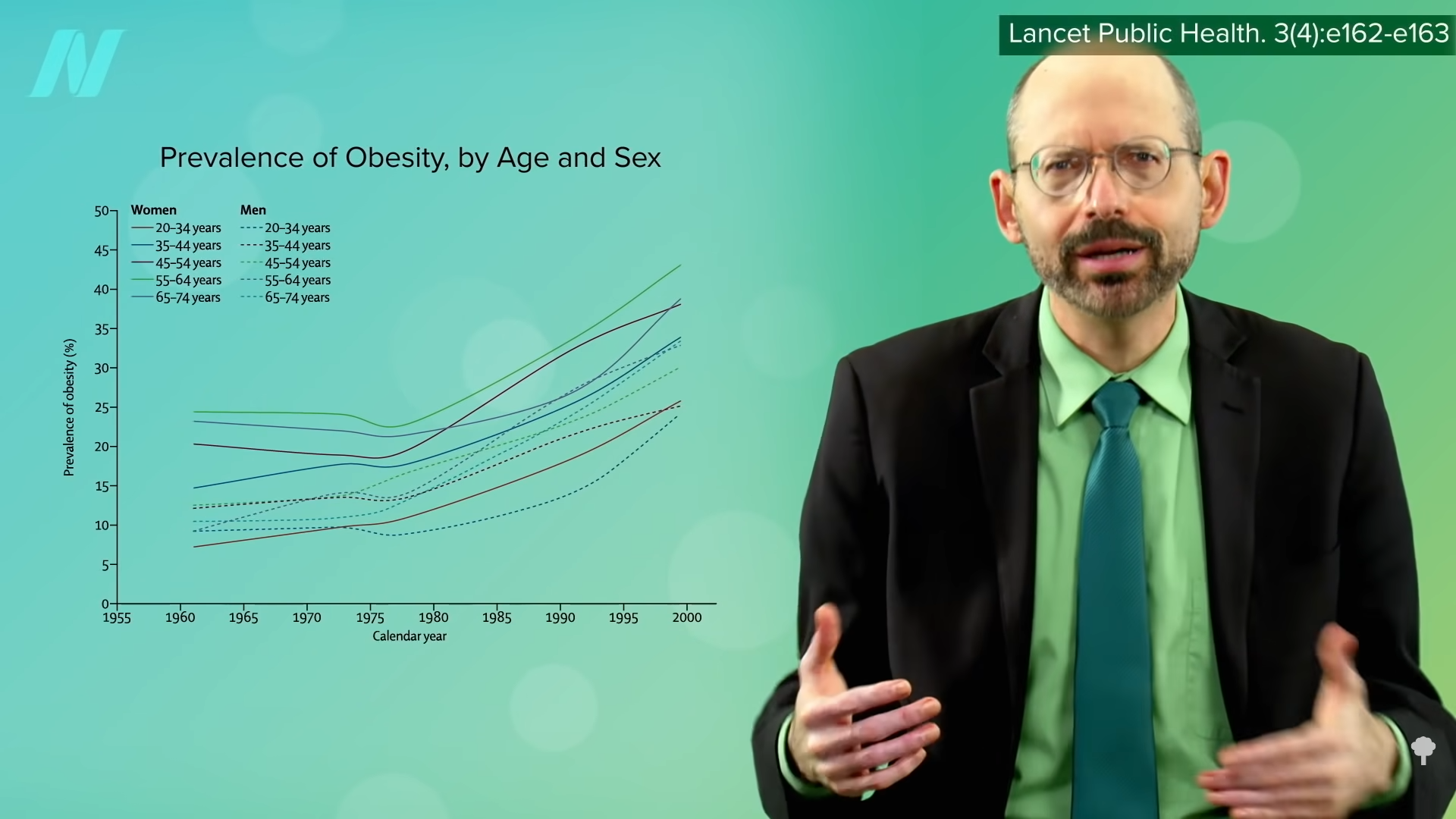The common explanations for the cause of the obesity epidemic put forward by the food industry and policymakers, such as inactivity or a lack of willpower, are not only wrong, but actively harmful fallacies.
Obesity isn’t new, but the obesity epidemic is. We went from a few corpulent kings and queens, like Henry VIII or Louis VI (known as Louis le Gros, or “Louis the Fat”), to a pandemic of obesity, now considered to be “arguably the gravest and most poorly controlled public health threat of our time.” As you can see below and at 0:34 in my video The Role of Diet vs. Exercise in the Obesity Epidemic, about 37 percent of American men are obese and 41 percent of American women, with no end in sight. Earlier reports had suggested that the rise in obesity was at least slowing down, but even that doesn’t appear to be the case. Similarly, we had thought we were turning the corner on childhood obesity “[a]fter 35 years of unremittingly bad news,” but the bad news continues. Childhood and adolescent obesity rates have continued to rise, now into the fourth decade.
Over the last century, obesity appears to have jumped ten-fold, from about 1 in 30 to now 1 in 3, but it wasn’t a steady rise. As you can see in the graph below and at 1:15 in my video, something seems to have happened around the late 1970s—and not just in the United States, but around the globe. The obesity pandemic took off at about the same time in the 1970s and 1980s in most high-income countries. The fact that the rapid rise “seemed to begin almost concurrently” across the industrialized world suggests a common cause. What might that trigger have been?

Any potential driver would have to be global and “coincide with the upswing of the epidemic.” So, the change would have had to have started about 40 years ago and would have had to have been able to spread rapidly around the globe. Let’s see how all the various theories stack up. For example, as you can see below and at 1:55 in my video, some have blamed changes in our built environment and shifts in city planning that have made our communities less conducive to walking, biking, and grocery shopping. That doesn’t meet our criteria for a credible cause, though, because there was no universal, simultaneous change in our neighborhoods within that time frame.

When researchers surveyed hundreds of policymakers, most blamed the obesity epidemic on a “lack of personal motivation.” Do you see how little sense that makes? In the United States, for example, obesity shot up across the entire population in the late 1970s, as you can see at 2:26 in my video. I concur with the researchers who “believe it is implausible that each age, sex, and ethnic group, with massive differences in life experience and attitudes, had a simultaneous decline in willpower related to healthy nutrition or exercise.” More plausible than a global change like our characters would be some global change like our lives.

The food industry blames inactivity. “If all consumers exercised,” said the CEO of PepsiCo, “obesity wouldn’t exist.” Coca-Cola went a step further, spending $1.5 million to create the Global Energy Balance Network to downplay the role of diet. Leaked emails show the company planned on using the front to “serve as a ‘weapon’ to ‘change the conversation’ about obesity in its ‘war’ with public health.
This tactic is so common among food and beverage companies that it even has a name: “leanwashing.” You’ve heard of greenwashing, where companies deceptively pretend to be environmentally friendly. Leanwashing is the term used to describe companies that try to position themselves as helping to solve the obesity crisis when they’re instead directly contributing to it. For example, the largest food company in the world, Nestlé, has “rebranded itself as the ‘world’s leading nutrition, health and wellness company.” Yes, that Nestlé, makers of Nesquik, Cookie Crisp, and historically more than a hundred different brands of candy, including Butterfinger, Kit Kat, Goobers, Gobstoppers, Runts, and Nerds. Another one of its slogans is “Good Food, Good Life.” Its Raisinets may have some fruit, but Nestlé seems to me more Willy Wonka than wellness.
The constant corporate drumbeat of overemphasis on physical inactivity appears to be working. In response to the Harris poll question, “Which of these do you think are the major reasons why obesity has increased?,” a “huge majority of 83% chose lack of exercise, while only 34% chose excessive calorie consumption.” “Confusion about the effect of exercise on the energy balance” has been identified as one of the most common misconceptions about obesity. The scientific community has “come to a fairly decisive conclusion” that the factors governing calorie intake more powerfully affect overall calorie balance. It’s our fast food more than our slow motion.
“There is considerable debate in the literature today about whether physical activity has any role whatsoever in the epidemic of obesity that has swept the globe since the 1980s.” The increase in caloric intake per person is more than enough to explain the obesity epidemic in the United States and also explain it globally. If anything, the level of physical activity over the last few decades has gone up slightly in both Europe and North America. Ironically, this may be a result of the extra energy it takes to move around our heavier bodies, making it a consequence of the obesity problem rather than the cause.
“Formal exercise plays a very small role in the total daily physical activity energy expenditure.” Think how much more physical work people used to do in the workplace, on the farm, or even in the home. It’s not just the shift in collar color from blue to white. Increasing automation, computerization, mechanization, motorization, and urbanization have all contributed to increasingly more sedentary lifestyles over the last century—and that’s the problem with the theory. The occupational shifts and advent of labor-saving devices “have been gradual and largely predated the dramatic increase in weight gain across the developed world in the past few decades.” Washing machines, vacuum cleaners, and the Model T were all invented before 1910. Indeed, when put to the test using state-of-the-art methods to measure energy in and energy out, it was caloric intake, not physical activity, that predicted weight gain over time.
The common misconception that obesity is mostly due to lack of exercise may not just be a benign fallacy. Personal theories of causation appear to impact people’s weight. Those who blame insufficient exercise are significantly more likely to be overweight than those who implicate a poor diet. Put those who believe lack of exercise causes obesity in a room with chocolate, and they can covertly be observed consuming more candy. Those holding that view may be different in other ways, though. You can’t prove cause and effect until you put it to the test. And, indeed, as you can see in the graph below, and at 7:22 in my video, people randomized to read an article implicating inactivity went on to eat significantly more sweets than those reading about research that indicated diet. A similar study found that those presented with research blaming genetics subsequently ate significantly more cookies. The title of that paper? “An Unintended Way in Which the Fat Gene Might Make You Fat.”

When I sat down to write How Not to Diet, I knew this “what triggered the obesity epidemic” was going to be a big question I had to face. Was it inactivity (just kids sitting around playing video games or scrolling on their phones)? Was it genetic? Was it epigenetic (something turning on our fat genes)? Or was it just the food? Were we eating more fat all of a sudden? More carbs? More processed foods? Or were we just eating more period, because of bigger serving sizes or more snacking? Inquiring minds wanted to know.
This is the first in an 11-video series to answer this question, which I originally released in a two-hour webinar in 2020. Check out the webinar digital download here. Or, check them out in the related posts below.

